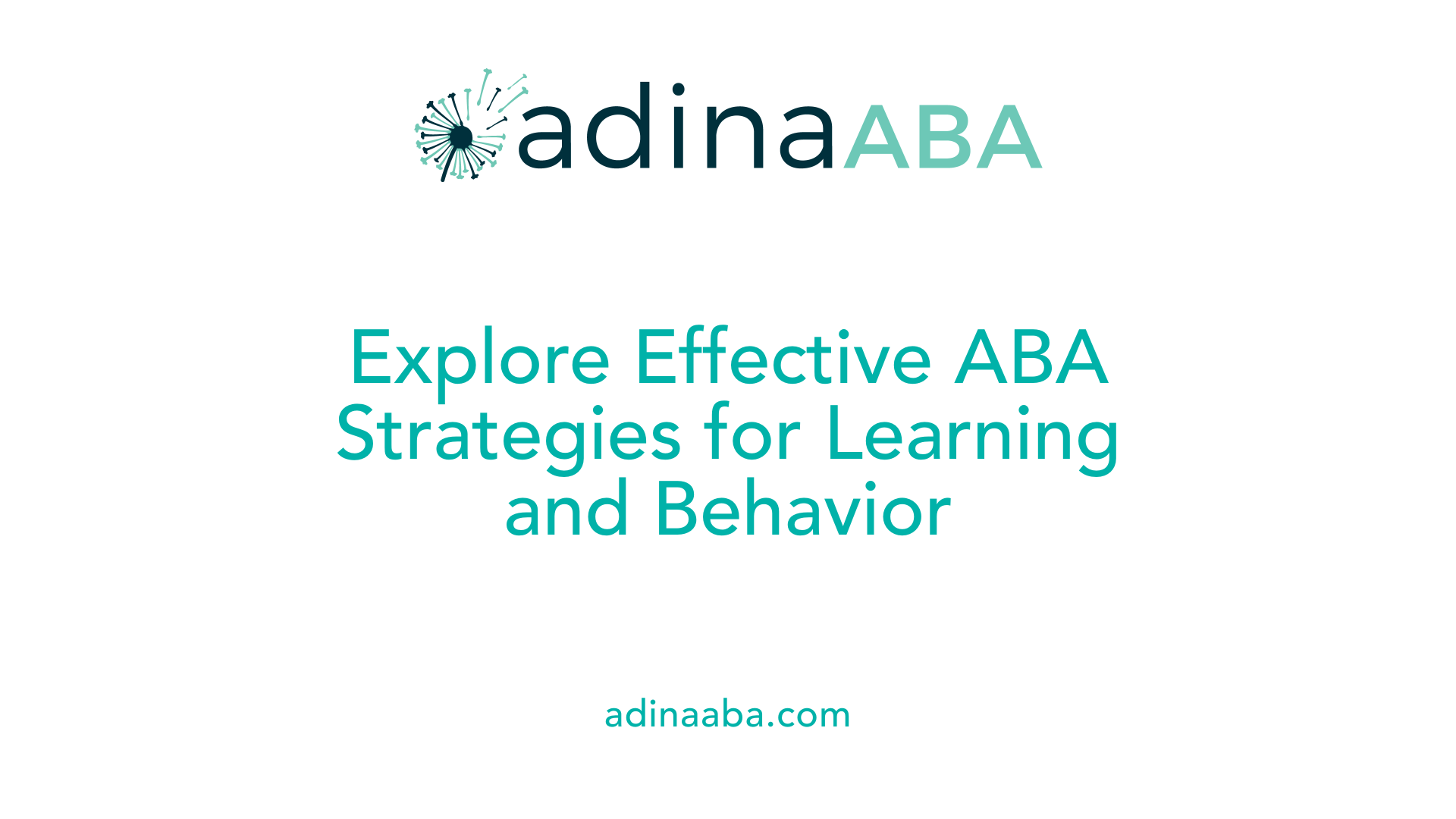Common At-Home ABA Therapy Techniques Used by Therapists

Exploring At-Home ABA Techniques for Children with Autism
Applied Behavior Analysis (ABA) therapy is a well-established method for aiding children with Autism Spectrum Disorder (ASD) in developing essential life and social skills. This article explores common ABA techniques that can be seamlessly integrated into home settings, providing parents with actionable insights to support their child's growth and development. By understanding the principles behind these strategies, parents can create a nurturing environment that fosters learning and behavioral improvements.
Core Strategies Used in ABA Therapy

What strategies do ABA therapists commonly use?
ABA therapists commonly use a variety of strategies to promote learning and positive behavior. Here are some of the most effective strategies:
Positive and Negative Reinforcement:
- Positive reinforcement involves adding a pleasant stimulus after a desired behavior, such as verbal praise or rewards.
- Negative reinforcement consists of removing an aversive factor to encourage repetition of a behavior, like allowing a break after a child has requested one effectively.
- Together, these techniques help communicate appropriate actions consistently.
Video Modeling:
- This method uses video recordings to demonstrate desirable behaviors, allowing children to learn by watching and imitating.
- Particularly beneficial for visual learners, it covers important social skills and emotional expressions.
Prompting and Fading:
- Initial support through cues (verbal or physical) aids learning new skills.
- As competency increases, prompts are gradually faded out, promoting greater independence in the child.
Natural Environment Teaching:
- Focused on real-life scenarios, this strategy enhances learning experiences by leveraging the child’s interests in their surroundings to promote functional skills.
Behavior Chains:
- This technique breaks complex tasks into manageable steps, helping children learn processes by mastering each segment before integrating them into a whole.
Generalization:
- Teaching children to apply learned skills across different contexts ensures they can utilize their knowledge beyond structured learning environments.
Behavior Contracts:
- Designed for slightly older children, these contracts set clear expectations and rewards for behavior, fostering accountability and reinforcing positive actions.
Principles of ABA Teaching Styles

What are some key ABA teaching styles?
Applied Behavior Analysis (ABA) employs various teaching styles tailored to the needs of children, particularly those with Autism Spectrum Disorder (ASD). Among the prominent approaches are:
Discrete Trial Training (DTT)
DTT breaks down complex skills into smaller, teachable parts. Each task is clearly defined, ensuring structured learning with immediate feedback, which helps in acquiring targeted skills.Pivotal Response Training (PRT)
This method emphasizes teaching pivotal behaviors that can positively affect a range of other skills. It creates a supportive environment encouraging motivation and resilience, making it excellent for social and communication development.Natural Environment Teaching (NET)
NET focuses on teaching skills within a child’s own environment, utilizing their interests to create engaging and meaningful learning experiences. This real-world application helps children generalize their skills beyond instructional settings.Incidental Teaching
This style leverages spontaneous opportunities in a child's natural interactions. By seizing these moments, teachers can promote learning in a spontaneous and engaging manner, enhancing the child’s ability to apply skills in fluid contexts.
These approaches support children’s learning by tailoring the educational experience to their unique needs, helping them thrive in various environments.
Supporting Your Child's Development with ABA at Home

How can parents support their child during in-home ABA therapy?
Parents play a vital role in the success of in-home ABA therapy. Their involvement can significantly enhance the effectiveness of the strategies implemented during sessions.
One of the most impactful ways for parents to support their child is by actively participating in therapy sessions. This involvement helps parents learn specific techniques from therapists that they can practice at home. For instance, applying positive reinforcement effectively can encourage desirable behaviors significantly.
Using ABA strategies effectively
Parents should collaborate with therapists to set specific, measurable goals for their children. Using visual schedules and positive reinforcement techniques can enhance learning and provide consistency in behavior management. Regularly practicing skills such as sitting still, eye contact, and emotion recognition can reinforce what the child learns in therapy.
Utilizing technology, such as AAC apps, can assist in communication and further encourage independence.
Tracking progress to ensure success
Tracking progress is crucial in understanding how well interventions are working. Parents should maintain consistent data collection on their child's behaviors and achievements. This documentation can provide insight into trends and help therapists adjust strategies accordingly.
Creating a supportive environment
It is essential to create a supportive environment that fosters learning. Activities tailored to the child’s interests can increase engagement. For example, incorporating games that promote social skills, such as taking turns or sharing, can make learning enjoyable.
Additionally, regular communication between parents and therapists about the child’s needs ensures a collaborative approach to therapy, respecting family dynamics and cultural considerations.
By actively learning and practicing ABA techniques at home, parents can create a nurturing atmosphere that supports their child's development and maximizes the effectiveness of therapy.
The Role of ABA Therapists in Home Settings

What role does an ABA therapist have in a home setting?
An ABA therapist plays a vital role in providing specialized treatment for children with autism directly in their homes. This familiar environment enhances the child's comfort and safety, which is crucial for effective learning. By conducting therapy sessions at home, therapists can utilize natural reinforcers, such as toys and family interactions, to make the learning experience more relatable and impactful.
The focus of in-home ABA therapy includes working on specific behaviors that are relevant to the child’s daily life. This can range from improving social interactions with family members to developing essential life skills like dressing and toileting. The presence of a therapist allows for structured guidance while the child engages in familiar routines, facilitating practical learning opportunities.
Why is parental involvement important?
Parental involvement is essential in this setting as it fosters consistency in the application of learned behaviors. Parents are encouraged to actively engage in therapy sessions, which helps reinforce skills and strategies that the child learns with the therapist. When parents apply these techniques within daily routines, they support their child's development outside of structured therapy sessions.
Overall, in-home ABA therapy serves not only to enhance the child’s learning but also to strengthen family dynamics by integrating parents and siblings into the therapeutic process. This holistic approach promotes a collaborative environment conducive to growth and skill mastery.
Implementing Positive Reinforcement at Home

Definition and Examples of Positive Reinforcement
Positive reinforcement is a technique used to increase desirable behaviors by introducing a rewarding stimulus after the desired action. For instance, if a child correctly identifies colors during a game, providing verbal praise or a small treat reinforces that behavior, encouraging them to repeat it in the future.
Benefits of Positive Reinforcement
Utilizing positive reinforcement can lead to numerous benefits in children:
- Encourages Positive Behavior: It motivates children to engage in socially acceptable behaviors.
- Builds Self-Esteem: Recognizing accomplishments helps boost a child's confidence.
- Strengthens Parent-Child Relationship: When parents acknowledge good behavior, it fosters mutual respect and communication.
Integrating into Daily Routines
To effectively implement positive reinforcement at home, consider these strategies:
- Create Opportunities: Use daily activities to identify moments for praise or rewards, such as during chores or homework.
- Be Consistent: Ensure all family members apply the reinforcement consistently to avoid confusion.
- Tailor Rewards: Customize the rewards based on your child's interests to enhance motivation.
By thoughtfully integrating these practices into daily life, parents can create a supportive environment that encourages and reinforces positive behaviors.
Augmented and Alternative Communication: Tools for Non-Verbal Children
What are AAC Methods?
Augmented and Alternative Communication (AAC) methods are essential for children who face challenges with verbal communication. AAC includes a range of non-verbal communication strategies such as:
- Sign Language: A visual language that uses gestures and signs to convey meaning.
- Picture Exchange Communication System (PECS): A method where children use pictures to express their needs and thoughts, greatly supporting non-verbal individuals.
- Communication Boards: Visual aids that display various symbols or images, allowing children to choose and point at what they want to say.
What are the Benefits of AAC in ABA Therapy?
Integrating AAC into ABA therapy provides several benefits:
- Enhanced Communication: It allows children to express needs more effectively, reducing frustration and challenging behaviors.
- Improved Social Interaction: With AAC tools, children can participate more fully in social situations, facilitating interaction with peers.
- Support for Learning: AAC tools can help bridge communication gaps, promoting skill acquisition in various settings.
What Technological Tools are Available for AAC?
Technology has significantly enhanced AAC solutions. Here are some innovative tools:
| Device Type | Description | Applications |
|---|---|---|
| AAC Apps | Mobile applications designed for communication needs | iPads and tablets for portable use |
| Speech Generating Devices | Devices that generate spoken language when activated | Great for facilitating communication in various settings |
| Visual Schedule Apps | Applications that help visualize daily routines | Helps in preparing children for transitions |
Utilizing these AAC methods and tools in conjunction with ABA therapy can greatly improve expressive language skills and overall communication for children on the autism spectrum.
Creating a Structured Routine for Successful Therapy
Importance of Routines in ABA
A structured routine is essential in ABA therapy as it provides predictability and stability for children. Knowing what to expect reduces anxiety and encourages engagement in learning activities. Routines help children feel secure and can enhance their ability to focus on learning new skills.
Steps to Create a Routine
- Assessment of Current Needs: Understand the child's current skills and behavioral challenges through an initial assessment with a trained ABA therapist.
- Setting Clear Goals: Define specific behavioral targets you wish to achieve in daily routines, such as communication or social skills.
- Daily Schedule Creation: Develop a visual schedule to outline daily activities, including time for therapy practices, play, and rest.
- Incorporating Fun Learning Activities: Choose engaging activities based on the child’s interests, like games or crafts, to maintain their enthusiasm.
- Consistent Implementation: Ensure that all family members are on board with the routine, practicing techniques consistently to support the child’s learning.
Modifying Routines Based on Needs
Flexibility is vital. If a particular approach isn’t successful, assess the reasons and adjust the routine accordingly. Consider the child’s mood, interests, or specific challenges, and always strive to make the activities enjoyable and effective, enhancing engagement and motivation.
Maximizing the Benefits of At-Home ABA
Integrating ABA therapy techniques into the home environment offers numerous benefits for children with autism and their families. By embracing strategies such as positive reinforcement, structured teaching styles, and communication tools, parents can play an integral role in their child's developmental journey. With consistent practice and collaboration with therapists, parents can create a supportive and effective learning atmosphere that encourages growth and independence. The power to shape a child's future is truly profound in the hands of dedicated caregivers committed to applying these life-changing techniques every day.
References
- 10 Common ABA Therapy Techniques
- ABA Therapy Activities To Do At Home - Autism Parenting Magazine
- ABA Therapy Techniques At Home To Try In 2022 - Joon
- ABA Therapy Techniques and Usage - First Step Arkansas
- Understanding ABA Techniques: 7 Strategies You Need to Know
- Unlocking Potential at Home: What is In-Home ABA Therapy?
- Understanding ABA Techniques: 7 Strategies You Need to Know
- ABA Therapy at Home: All You Need to Know
- ABA Therapy Activities To Do At Home - Autism Parenting Magazine
More Resources
Expert Clinicians
Get started today ->


.jpg)
.jpg)

.jpg)
.jpg)



















































































































































































































































































































































































































































.jpg)
.jpg)
.jpg)
.jpg)
.jpg)
.jpg)
.jpg)
.jpg)
.jpg)
.jpg)
.jpg)
.jpg)
.jpg)
.jpg)
.jpg)
.jpg)
.jpg)
.jpg)
.jpg)
.jpg)
.jpg)
.jpg)
.jpg)
.jpg)

.jpg)
.jpg)
.jpg)
.jpg)
.jpg)
.jpg)
.jpg)
.jpg)
.jpg)
.jpg)
.jpg)
.jpg)
.jpg)
.jpg)
.jpg)
.jpg)
.jpg)
.jpg)
.jpg)
.jpg)
.jpg)
.jpg)
.jpg)
.jpg)





































































































































































































.jpg)


































































.jpg)
.jpg)
.jpg)
.jpg)
.jpg)
.jpg)
.jpg)
.jpg)
.jpg)
.jpg)
.jpg)
.jpg)
.jpg)
.jpg)
.jpg)
.jpg)
.jpg)
.jpg)
.jpg)
.jpg)
.jpg)
.jpg)
.jpg)
.jpg)
.jpg)
.jpg)
.jpg)
.jpg)
.jpg)
.jpg)
.jpg)
.jpg)
.jpg)
.jpg)


.jpg)
.jpg)
.jpg)
.jpg)
.jpg)
.jpg)
.jpg)
.jpg)
.jpg)
.jpg)
.jpg)
.jpg)
.jpg)
.jpg)
.jpg)
.jpg)
.jpg)
.jpg)
.jpg)
.jpg)
.jpg)
.jpg)
.jpg)
.jpg)
.jpg)
.jpg)
.jpg)


.jpg)
.jpg)
.jpg)
.jpg)
.jpg)
.jpg)
.jpg)
.jpg)
.jpg)
.jpg)
.jpg)
.jpg)
.jpg)
.jpg)
.jpg)
.jpg)
.jpg)
.jpg)
.jpg)

.jpg)

.jpg)



































































































.jpg)
.jpg)
.jpg)
.jpg)
.jpg)
.jpg)
.jpg)
.jpg)
.jpg)
.jpg)
.jpg)
.jpg)
.jpg)
.jpg)
.jpg)
.jpg)
.jpg)
.jpg)
.jpg)
.jpg)
.jpg)
.jpg)
.jpg)
.jpg)
.jpg)
.jpg)
.jpg)
.jpg)
.jpg)
.jpg)
.jpg)
.jpg)
.jpg)
.jpg)
.jpg)
.jpg)
.jpg)
.jpg)
.jpg)
.jpg)
.jpg)
.jpg)
.jpg)
.jpg)
.jpg)
.jpg)
.jpg)

.jpg)
.jpg)
.jpg)
.jpg)
.jpg)
.jpg)
.jpg)
.jpg)
.jpg)
.jpg)
.jpg)
.jpg)
.jpg)
.jpg)

.jpg)
.jpg)
.jpg)
.jpg)
.jpg)
.jpg)
.jpg)
.jpg)
.jpg)
.jpg)
.jpg)
.jpg)
.jpg)
.jpg)

.jpg)
.jpg)
.jpg)
.jpg)
.jpg)
.jpg)
.jpg)
.jpg)
.jpg)
.jpg)
.jpg)
.jpg)
.jpg)
.jpg)

.jpg)
.jpg)
.jpg)
.jpg)
.jpg)
.jpg)
.jpg)
.jpg)
.jpg)
.jpg)
.jpg)
.jpg)
.jpg)
.jpg)

.jpg)
.jpg)
.jpg)
.jpg)
.jpg)
.jpg)
.jpg)
.jpg)
.jpg)
.jpg)
.jpg)
.jpg)
.jpg)
.jpg)

.jpg)
.jpg)
.jpg)
.jpg)
.jpg)
.jpg)
.jpg)
.jpg)
.jpg)
.jpg)
.jpg)
.jpg)
.jpg)
.jpg)
.jpg)
.jpg)
.jpg)
.jpg)
.jpg)
.jpg)
.jpg)
.jpg)
.jpg)
.jpg)
.jpg)
.jpg)
.jpg)
.jpg)
.jpg)
.jpg)
.jpg)
.jpg)
.jpg)
.jpg)
.jpg)
.jpg)
.jpg)
.jpg)
.jpg)
.jpg)
.jpg)
.jpg)
.jpg)
.jpg)
.jpg)
.jpg)
.jpg)
.jpg)

.jpg)
.jpg)
.jpg)
.jpg)
.jpg)
.jpg)
.jpg)
.jpg)
.jpg)
.jpg)
.jpg)
.jpg)
.jpg)
.jpg)
.jpg)
.jpg)
.jpg)
.jpg)
.jpg)
.jpg)
.jpg)
.jpg)
.jpg)
.jpg)
.jpg)

.jpg)
.jpg)
.jpg)
.jpg)
.jpg)
.jpg)
.jpg)
.jpg)
.jpg)
.jpg)
.jpg)
.jpg)
.jpg)
.jpg)
.jpg)
.jpg)
.jpg)
.jpg)
.jpg)
.jpg)
.jpg)
.jpg)
.jpg)

.jpg)
.jpg)
.jpg)
.jpg)
.jpg)
.jpg)
.jpg)
.jpg)
.jpg)
.jpg)
.jpg)
.jpg)
.jpg)
.jpg)
.jpg)
.jpg)
.jpg)
.jpg)
.jpg)
.jpg)
.jpg)
.jpg)
.jpg)

.jpg)
.jpg)
.jpg)
.jpg)
.jpg)
.jpg)
.jpg)
.jpg)
.jpg)
.jpg)
.jpg)
.jpg)
.jpg)
.jpg)
.jpg)
.jpg)
.jpg)
.jpg)
.jpg)
.jpg)
.jpg)
.jpg)
.jpg)
.jpg)
.jpg)
.jpg)
.jpg)
.jpg)
.jpg)
.jpg)
.jpg)
.jpg)
.jpg)
.jpg)
.jpg)
.jpg)
.jpg)
.jpg)
.jpg)
.jpg)
.jpg)
.jpg)
.jpg)
.jpg)
.jpg)
.jpg)
.jpg)

.jpg)
.jpg)
.jpg)
.jpg)
.jpg)
.jpg)
.jpg)
.jpg)
.jpg)
.jpg)
.jpg)
.jpg)
.jpg)
.jpg)
.jpg)
.jpg)
.jpg)
.jpg)
.jpg)
.jpg)
.jpg)
.jpg)
.jpg)
.jpg)

.jpg)
.jpg)
.jpg)
.jpg)
.jpg)
.jpg)
.jpg)
.jpg)
.jpg)
.jpg)
.jpg)
.jpg)
.jpg)
.jpg)
.jpg)
.jpg)
.jpg)
.jpg)
.jpg)
.jpg)
.jpg)
.jpg)
.jpg)
.jpg)
.jpg)

.jpg)
.jpg)
.jpg)
.jpg)
.jpg)
.jpg)
.jpg)
.jpg)
.jpg)
.jpg)
.jpg)
.jpg)
.jpg)
.jpg)
.jpg)
.jpg)
.jpg)
.jpg)
.jpg)
.jpg)
.jpg)
.jpg)
.jpg)
.jpg)
.jpg)
.jpg)
.jpg)
.jpg)
.jpg)
.jpg)
.jpg)
.jpg)
.jpg)
.jpg)
.jpg)
.jpg)
.jpg)
.jpg)
.jpg)
.jpg)
.jpg)
.jpg)
.jpg)
.jpg)
.jpg)
.jpg)
.jpg)

.jpg)
.jpg)
.jpg)
.jpg)
.jpg)
.jpg)

.jpg)
.jpg)
.jpg)
.jpg)
.jpg)
.jpg)
.jpg)
.jpg)
.jpg)
.jpg)
.jpg)
.jpg)
.jpg)
.jpg)
.jpg)
.jpg)

.jpg)
.jpg)
.jpg)
.jpg)
.jpg)
.jpg)
.jpg)
.jpg)
.jpg)
.jpg)
.jpg)
.jpg)
.jpg)
.jpg)
.jpg)
.jpg)
.jpg)
.jpg)
.jpg)
.jpg)
.jpg)
.jpg)
.jpg)

.jpg)
.jpg)
.jpg)
.jpg)
.jpg)
.jpg)
.jpg)
.jpg)
.jpg)
.jpg)
.jpg)
.jpg)
.jpg)
.jpg)
.jpg)
.jpg)
.jpg)
.jpg)
.jpg)
.jpg)
.jpg)

.jpg)
.jpg)
.jpg)
.jpg)
.jpg)
.jpg)
.jpg)
.jpg)
.jpg)
.jpg)
.jpg)
.jpg)
.jpg)
.jpg)
.jpg)
.jpg)
.jpg)
.jpg)
.jpg)
.jpg)
.jpg)
.jpg)
.jpg)
.jpg)
.jpg)
.jpg)
.jpg)

.jpg)
.jpg)
.jpg)
.jpg)
.jpg)
.jpg)
.jpg)
.jpg)
.jpg)
.jpg)
.jpg)
.jpg)
.jpg)
.jpg)
.jpg)
.jpg)
.jpg)
.jpg)
.jpg)
.jpg)
.jpg)
.jpg)
.jpg)
.jpg)
.jpg)
.jpg)
.jpg)
.jpg)
.jpg)
.jpg)
.jpg)

.jpg)
.jpg)
.jpg)
.jpg)
.jpg)
.jpg)
.jpg)
.jpg)
.jpg)
.jpg)
.jpg)
.jpg)
.jpg)
.jpg)
.jpg)
.jpg)
.jpg)
.jpg)
.jpg)
.jpg)
.jpg)
.jpg)
.jpg)
.jpg)
.jpg)
.jpg)
.jpg)
.jpg)
.jpg)
.jpg)
.jpg)
.jpg)
.jpg)
.jpg)
.jpg)
.jpg)
.jpg)
.jpg)
.jpg)
.jpg)
.jpg)
.jpg)
.jpg)
.jpg)
.jpg)
.jpg)
.jpg)
.jpg)
.jpg)
.jpg)
.jpg)
.jpg)
.jpg)
.jpg)
.jpg)
.jpg)
.jpg)
.jpg)
.jpg)
.jpg)
.jpg)
.jpg)
.jpg)
.jpg)
.jpg)
.jpg)

.png)
.png)
.png)
.png)
.png)
.png)
.png)
.png)
.png)

.jpg)
.jpg)
.jpg)
.jpg)
.jpg)
.jpg)
.jpg)
.jpg)
.jpg)
.jpg)
.jpg)
.jpg)

.jpg)
.jpg)
.jpg)
.jpg)
.jpg)
.jpg)
.jpg)
.jpg)
.jpg)
.jpg)
.jpg)
.jpg)
.jpg)
.jpg)
.jpg)
.jpg)
.jpg)
.jpg)
.jpg)
.jpg)
.jpg)

.png)
.png)
.png)
.png)
.png)
.png)
.png)
.png)
.png)
.png)
.png)
.png)
.png)
.png)
.png)
.png)
.png)
.png)
.png)
.png)
.png)
.png)

.png)


.jpg)
.jpg)
.jpg)
.jpg)
.jpg)
.jpg)
.jpg)
.jpg)

.jpg)
.jpg)
.jpg)
.jpg)
.jpg)
.jpg)
.jpg)
.jpg)
.jpg)
.jpg)
.jpg)
.jpg)
.jpg)
.jpg)
.jpg)
.jpg)
.jpg)
.jpg)
.jpg)
.jpg)
.jpg)
.jpg)
.jpg)



























.jpg)
.jpg)

.jpg)
.jpg)
.jpg)
.jpg)
.jpg)
.jpg)
.jpg)
.jpg)
.jpg)
.jpg)
.jpg)
.jpg)
.jpg)
.jpg)
.jpg)
.jpg)
.jpg)
.jpg)
.jpg)
.jpg)
.jpg)

.jpg)
.jpg)
.jpg)
.jpg)
.jpg)
.jpg)
.jpg)
.jpg)
.jpg)
.jpg)
.jpg)
.jpg)
.jpg)
.jpg)
.jpg)
.jpg)
.jpg)
.jpg)
.jpg)
.jpg)
.jpg)
.jpg)
.jpg)

.jpg)
.jpg)
.jpg)
.jpg)
.jpg)
.jpg)
.jpg)
.jpg)
.jpg)
.jpg)
.jpg)
.jpg)
.jpg)
.jpg)
.jpg)
.jpg)
.jpg)
.jpg)

.jpg)
.jpg)
.jpg)
.jpg)

